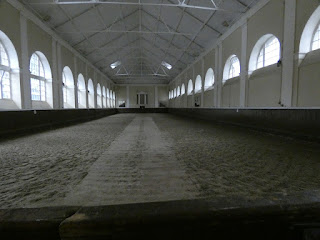There was an open day at the Buckingham Palace Gardens, and I went with my camera.
Entrance was through the Royal Mews, with a view of the beautiful 18th century indoor riding school. The steel supports on the ceiling look like a modern addition.
Once in the garden, you see the back of the palace, a handsome structure in mellow Bath stone of which the oldest parts, built for John Sheffield, later the Duke of Buckingham, date from 1703. It has been much extended and remodelled, the latest work being a new front added in 1913 in harsh grey Portland stone, a storey higher than the rest of the building, and that is the familiar view seen by tourists. The older parts are much more to my taste.
The wildlife is pretty much the same as in the adjacent public parks, as you would expect, and there were no surprises. It was sad to discover that the Flamingos that once lived on the lake had been killed by a fox in 1996.
The highlight was a brood of Tufted ducklings energetically diving. Tufted Ducks have difficulty breeding in the more open landscape of the parks and seldom succeed.
There were also Mallard ducklings.
I was expecting to see Gadwalls, as I have been told that they breed here, and saw some adults though there was no sign of ducklings.
There are Coot nests all around the lake ...
... some of them taken over by Egyptian Geese.
A teenage Moorhen looked after a chick, as is the pleasant custom of Moorhens, which may breed three times in a year.
The lawns, long established and beautifully kept, are full of worms which attract Herring Gulls and Lesser Black-Backed Gulls. A young Lesser Black-Back took a rest from worm hunting.
Don't get too excited, these Common Cranes are sculptures.
The staff, who were very friendly and helpful, told me that Sparrowhawks had arrived recently. These are certainly the ones from Hyde Park, and it explains why I haven't seen the adults in the park, only the two young ones. This meant that the small birds in the palace gardens were keeping their heads down. Wrens, Great Tits and Long-Tailed Tits could be heard in the bushes but not seen. However, a Robin came out and stared boldly at the visitors.
A female Common Darter dragonfly perched on a twig.
A Honeybee explored some big yellow flowers that PlantNet told me were Silphium perfoliatum.
I immediately thought of the famous silphium plant of classical antiquity, whose many uses included flavouring food, medicines for various conditions, and acting as a contraceptive, and which became extinct at an early date through over-harvesting. But that was a completely different plant, and this one is a kind of aster from North America. Its common name is the Cup Plant, because its leaves trap rainwater, making it an important asset to wildlife.












According to the Royal website, the west façade is of Bath stone.
ReplyDeleteThey tried Lesser Flamingoes on the ornamental pond in Golders Hill Park for a few years circa 1980, but after at least one was killed by a fox they had to relocate the rest to an aviary enclosure, where they looked sad and dejected. Captive ducks increasingly had to be kept behind chain link too, I'm not sure whether because of foxes, poaching or vandals.
Did any of the Lesser Black-backs on the lawn know the worm dance, or have you seen them do it anywhere yet? Jim
Thanks for putting me right about the stone. Have changed the blog.
DeleteI was watching those gulls, about fifty Herring and Lesser Black-Back, to see if there were any doing the worm dance. I didn't see it. On the other hand they seemed to be getting food just by strolling around, so perhaps they didn't need to.
But yes, I have seen LBBs do the worm dance -- just twice, both in the Diana fountain enclosure where the Herring Gulls dance regularly. I think their normal worm-charming technique is to peck the ground.
Also, Bath stone is a limestone.
DeleteA little surprising that about the gulls today, had it just rained there? I don't suppose that lawn visitors were treading would just have been humanly watered, or were the gulls in an out-of-bounds area? Jim
Thanks. I'm surprised that that yellow-brown stone is limestone.
DeleteIt had drizzled during the morning, and the grass was still a bit damp.